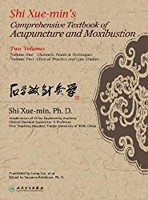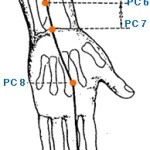Awakening a Child From a Vegetative State with Xing Nao Kai Qiao Acupuncture

Persistent vegetative states (or "unresponsive wakefulness syndrome") arise following brain damage leaving the patients in a state of partial arousal. While potential outcomes will vary depending on the causal factors, after 3-6 months chances for a complete recovery are considered low and generally get lower as time progresses ( 1 ). For children under western medical care, one study, described potential outcomes as follows: "The long-term outcome for children discharged from the hospital in a persistent vegetative state was poor. Forty percent of the patients died and, at best, children showed only minimal awareness after an average of 4.5 yrs. Care costs were > $90,000/yr per patient." ( 2 ).
Stroke recovery and the treatment of related neurological conditions are often treated by Chinese Medicine. A few years ago I wrote a brief review of a documentary entitled 9000 Needles
Publishing in the frontiers in medicine journal a team using Dr. Shi's system recently submitted a case report of the return of a 5 year old, 3 months into a persistent vegetative state, to a nearly completely recovered state after 50 days of treatment. The treatment was offered within the Xi'an Encephalopathy Hospital of Traditional Chinese Medicine in Xi'an, China.
The treatment offered was a combination therapy including Dr. Shi's "Xing Nao Kai Qiao" acupuncture method, oral "An Gong Niu Huang Wan" Chinese herbal formula, and "Xing Nao Jing" herbal formula via IV drip. After the 50 day treatment the team reported that the child had "his health significantly improved and is nearly similar to that of a healthy child". In this article, I'm going to explore the basics of their treatment - note, however, that I am only marginally familiar with the approaches of Dr. Shi and do not have a relationship with these particular researchers.
Dr. Shi's "Xing Nao Kai Qiao", "activate the brain and open the orifices", method is drawn from his many years of clinical experience, particularly with stroke and other neurological conditions. The general points used are as follows. The primary points are always used and then some additional points would be used for each individual case.
- Main Points:
 PC 6 "inner pass" - influences the median nerve, used in TCM for a range of psychological issues, nausea, and opening and relaxing the chest.
PC 6 "inner pass" - influences the median nerve, used in TCM for a range of psychological issues, nausea, and opening and relaxing the chest.- SP 6 "three yin intersection" - influences the tibial nerve, used in TCM to tonify the yin and the blood for a range of psychological and menstrual conditions, clearing what we call "heat" in the blood.
- GV 26 "water through" - with PC 6 forms a set of "command points" for the chest, heart and epigastrium areas, a very useful point for recovering from shock and/or fainting, as well as other psychological and neurological conditions such as epilepsy.
- Secondary Points:
- HT 1 "highest spring" - used for a range of shoulder and arm issues, but also tension in the chest and anxiety issues.
- LU 5 "cubit marsh" - useful for a range of shoulder/arm/elbow issues, but of more relevance here for removing what we would call phlegm heat in Chinese Medicine.
- UB 40 "bend middle" - another "command" point, this one for the lumbar region, but of more relevance here, used for clearing heat in cases of heatstroke and related issues.
- Dysphasia Points:
- GB 20 "wind pool" - an important point for dispelling "wind" in Chinese Medicine terms, symptoms such as vertigo, dizziness, numbness, etc., a "cva" in Chinese Medicine terms may be called a "wind stroke" alluding to the damage a strong "wind" can do.
- GB 12 "completion bone" - another point for dispelling "wind" in the head,
tinnitus, tremors, also some cases of insomnia and/or anxiety. - SI 17 "celestial countenance" - a "window of the sky" point, used to open the throat but also has a role in improving circulation to the brain.
- Asphasia Points:
- CV 23 "ridge spring" - commonly used in stroke patients to aid speech and swallowing.
- Jinjin and Yuye "golden fluid and jade fluid" - a pair of "extra points" used for post stroke asphasia, but also other issues with the tongue and/or speech, or swelling of the tongue that restricts breathing.
- Hand and Finger Paralysis:
- LI 4 "union valley" - a commonly used point to release wind-heat or wind-cold in Chinese Medicine terms, strengthens immunity, used for many facial issues involving pain or mobility.
- Bafeng and Sifeng "eight winds and four cracks" - "extra points" between the toes (bafeng) and the finger joints (sifeng) clinically noted for issues such as malaria and deep digestive issues, but used as strong local stimulators for stroke and other conditions.
Treatment is, if possible, offered twice daily for 10 days per course. Often 3-5 courses of treatment are required. The case report here, as an example, was 50 days of consecutive treatment.
Further exploration of Dr. Shi's work can be started by reading "Shi Xuemin's Comprehensive Textbook Of Acupuncture And Moxibustion, Volumes 1& 2
Now onto the Chinese herbal formula "An Gong Niu Huang" or "Calm the Palace Pill with Cattle Gallstone". This formula is a strong herbal formula primarily used in patients who are unconscious and/or have had a stroke. The herbal ingredients are generally as follows:
Cattle Gallstone (Niu Huang), Rhinoceros Horn (Xi Jiao) * substituted with Water Buffalo Horn (Shui Niu Jiao), Navel Gland Secretions of Musk Deer (She Xiang), Coptis Rhizome (Huang Lian), Baical Skullcap Root, Scutellaria (Huang Qin), Cape Jasmine Fruit, Gardenia (Zhi Zi), Realgar (Xiong Huang), Borneol (Bing Pian), Tumeric Tuber (Yu Jin), Cinnabar (Zhu Sha), Pearl (Zhen Zhu).
This particular formula has been used for hundreds of years for a range of central nervous system issues and for resuscitation. A fairly lengthy clinical exploration of this formula, case studies and clinical applications may be read here.
The other formula that was given via IV, Xing Nao Jing, is used for stroke and other neurological conditions. A study exploring how it helps may be read here.
Exploring this case study is a useful enterprise for practitioners of Chinese Medicine as well as neurologists and other specialists from the western medical side. In many of these types of cases a combination approach of western and eastern medicine would in most cases be best. It is nice to see that type of integration happening in Chinese hospitals and perhaps with more studies of this nature that interest in integration will continue in western countries as well.
tag @yinyanghouse for questions/comments
- Borneol (Bing Pian)
- Coptis Rhizome (Huang Lian)
- Baical Skullcap Root, Scutellaria (Huang Qin)
- Cattle Gallstone (Niu Huang)
- Navel Gland Secretions of Musk Deer (She Xiang)
- Rhinoceros Horn (Xi Jiao)
- Realgar (Xiong Huang)
- Tumeric Tuber (Yu Jin)
- Pearl (Zhen Zhu)
- Cape Jasmine Fruit, Gardenia (Zhi Zi)
- Cinnabar (Zhu Sha)